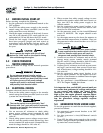
Generac
®
Power Systems, Inc. 17
1.17.1 BATTERY INSTALLATION
Fill the battery with the proper electrolyte fluid if nec-
essary and have the battery fully charged before
installing it.
Before installing and connecting the battery, complete
the following steps:
1. Set the generator's Auto/Off/Manual switch
to OFF.
2. Turn off utility power supply to the transfer
switch.
If the Auto/Off/Manual switch is not set to its
OFF position, the generator can crank and start
as soon as the battery cables are connected. If
the utility power supply is not turned off,
sparking can occur at the battery posts and
cause an explosion.
Battery cables were factory connected at the genera-
tor (Figure 1.14). Connect cables to battery posts as
follows:
1. Connect the red battery cable (from starter con-
tactor) to the battery post indicated by a positive,
POS or (+).
2. Connect the black battery cable (from frame
ground) to the battery post indicated by a nega-
tive, NEG or (—).
Figure 1.14 – Battery Cable Connections
NOTE:
With the battery installed and utility power source
voltage available to the transfer switch, the battery
receives a trickle charge while the engine is not
running, to prevent self-discharge. The trickle
charge feature cannot be used to recharge a dis-
charged battery.
1.18 THE FUSE
The generator panel’s 15-amp fuse protects the DC
control circuit against overload. The fuse is wired in
series with the battery output lead to the panel. If the
fuse element has melted open, you cannot crank or
start the engine. You should replace the fuse using
only an identical 15-amp replacement.
1.19 POST INSTALLATION INSPECTION
Before placing the home standby electrical system
into service, inspect the entire installation carefully.
Some areas may require that an inspection be per-
formed by a building or electrical inspector.
◆
Section 1 — Installation
Guardian Air-cooled Generators
Figure 1.15 – Typical Emergency Power System


















